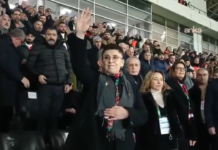Now that Turkey is heading towards a referendum that may, or may not, change the type of democracy that the Turkish political system features, some comments on the Turkish political opposition’s ideological outlook are appropriate. In recent weeks it has come to my attention that many members of Turkey’s old-school (Kemalist, or Kemalist-leftist) intellectual and socio-political elites see the referendum as a type of “counter-revolution,” and one person has even tried to explain to me that the referendum is a “parliament-based counter-revolution.” Absurd as it is, this is the dominant narrative, taken in all seriousness, among a broad group of Turkey’s university-educated, professional upper- and upper-middle-classes. Some (but not all) among them self-identify as “national-leftists,” or ulusalcı in Turkish.
Unfortunately, this sort of socio-political phenomenon won’t appear in the international press reports on the referendum. The essential reason is that most foreign journalists will not even perceive this and take notice, while those that do will not be aware that it is something worth commenting on. However, this apprehension of the proposed constitutional changes as a counter-revolution is one cause for the feverish, indeed virtually hysterical atmosphere under which the domestic discussion is taking place. That hysteria then gets translated abroad through the international press, and becomes an element (but definitely not the sole cause) contributing to the kind of events we witnessed last weekend in Germany and the Netherlands.
The associated topic that deserves far more attention from the international press is the continuing presence of Marxist-inspired ideological strains in Turkish politics. Even though the Cold War ended 25 years ago, Marxism (specifically Marxism-Leninism) remains influential in Turkey and Turkish politics. This is true especially among the university-educated, for some of whom history does not seem to have pronounced any verdict on Marxism and communism. Of course, also alive are several violent Turkish militant organizations that profess Marxist ideology, including the PKK (Kurdish Workers’ Party) and its various regional manifestations, the DHKP-C (Revolutionary People’s Liberation Party-Front), and the MLKP (Marxist-Leninist Communist Party), all of which are still carrying out attacks on Turkish society, though the capabilities of the last two in this regard cannot possibly be compared with the PKK). Thus, an important aspect of understanding Turkish politics today is seeing the continuing role that ideas based ultimately in Marxist doctrine play in Turkey’s left-of-center political movements. Also relevant are which segments of Turkish society generally provide support to those movements. In order to address this topic, we have to go back to the Turkish War for Independence, when Mustafa Kemal allowed, even encouraged, openly communist organizations to participate in the struggle against the Entente powers occupying Ottoman-Turkish territory in Anatolia.
Recently, I’ve been making my way through Steven Kotkin’s first massive volume of his Stalin biography. Kotkin’s book focuses on Stalin, the Bolsheviks, and Russia, of course; but much of what he explains is highly relevant to Turkey. On that count, one of the most effective aspects of Kotkin’s book is how ideology and mentalities affected the decisions that Lenin, Stalin, Trotsky, and others made, and which eventually gave the world the Soviet Empire.
For example, Americans who consider themselves to be interested in Marxist ideology or the progressive left should pay attention to Kotkin’s descriptions of how Lenin, Stalin, and Trutsky used Marxism to justify their decisions at certain political junctures. Their adaptation of Marxism, a worldview predicated on a particular way of theorizing class conflict in industrialized market societies, to a non-industrial, largely peasant society was a permanent mutation which made Marxism useful for non-Western anti-colonial activists or militants. It provided such agitators with another ideological weapon for pursuing their efforts to eject colonial forces from their societies while obtaining aid from sympathetic foreigners.
An early national movement which flirted with the Bolsheviks was Mustafa Kemal’s Turkish nationalists. As is well known, the Bolsheviks sent gold and weapons to Ankara after a friendship pact was signed between the two sides in March 1921. Lenin had more in mind than just trying to shore up his southern flank. He had previously interpreted the Committee of Union and Progress uprising (or coup?) that forced Abdülhamit II to call parliamentary elections in 1908 as a “bourgeois” revolution (1). According to Lenin, such revolutions needed to be helped along because they were a necessary step on the road to the proletarian revolution. This opened the doors to giving aid to anti-colonial or anti-imperialist nationalist movements, and the Turkish nationalists were the first to receive such Soviet help and assistance (2).
Kotkin devotes more than a dozen pages to describing how, in the mid-1920s, Stalin persisted in providing money and guns to the Chinese Kuomintang (the national/ist party) despite many signs that the Kuomintang was going to “betray” him by turning “counter-revolutionary” and cracking down on the Kungchantang (the communist party). Stalin knew his Lenin exceptionally well, so he believed that communists should inculcate themselves into the Kuomintang, a “bourgeois-nationalist” movement according to Marxist analysis, both to push it along the anti-imperialist road as far as possible and in anticipation of the future proletarian revolutionary moment. Chiang Kai-shek beat them to the punch by physically eliminating communists from his organization after he felt they had served his purpose (3).
What Kotkin does not explain is that Mustafa Kemal had done the same thing to the Bolsheviks’ Turkish extensions in 1920-1921. In 1920, Mustafa Kemal allowed an openly left-wing paramilitary organization, the so-called Green Army (Yeşil Ordu) to constitute itself and carry out raids against the occupying Entente powers. In early September 1920, Mustafa Suphi and his comrades set up a genuine Communist Party of Turkey in Baku under the aegis of what was already taking shape as the Communist International. In direct and immediate response, in late-October 1920 (i.e. only a month and a half later) Mustafa Kemal arranged for some of his associates to establish an official Turkish Communist Party so as to have a controllable alternative.
In early 1921, the Green Army, which had served its purpose and gained too much prominence, was suppressed by Mustafa Kemal’s order. Its military arm had been taken over by a bandit-turned-partisan by the name of Ethem the Circassian (Çerkes Ethem). During the liquidation of the Green Army Ethem, fearing the worst, turned renegade and sought refuge with the Greek army. Also in early 1921, a top group of Moscow-backed communists led by Mustafa Suphi himself, who were trying to cross over to Anatolia and join the national resistance, were murdered on the Black Sea. It is clear that Mustafa Kemal disliked and distrusted their attempt to insert themselves into the situation and struggle in Anatolia, though there is no evidence that he directly ordered their physical elimination. Instead, it is Kâzım Karabekir who has been traditionally blamed. In any case, the Kemalists were careful to exercise a complete monopoly over political space and processes in Anatolia. Nevertheless, Lenin let bygones be bygones, and Moscow signed a Friendship Treaty with Mustafa Kemal’s government a month after Suphi and his companions were killed. Eventually, the official Turkish Communist Party, too, would be outlawed in 1922.
Even though the Bolsheviks’ experience with the Turkish nationalists should have been a cautionary lesson, for largely ideological reasons Stalin stubbornly tried to pursue the same ploy with the Chinese nationalists. The result was the same, and Stalin either refused or was not able to analyze the Kuomintang movement in terms other than Leninist ideology (4). Turkish communism, which was never a widespread ideology in Turkish society, would have to wait until the 1960s to emerge from the underground. But that initial period during which Mustafa Kemal carefully used Bolshevik support to help the Turkish nationalist cause would later provide important material for Turkey’s leftists.
(to be continued)
NOTES
(1) See: “The Right of Nations to Self-Determination”; Point 3: “The Concrete Features of the National Question in Russia and Russia’s Bourgeois-Democratic Reformation” (1914); The State and Revolution, Chapter III, Part 1, “What was Heroic about the Communards’ Attempt?” (1917).
(2) This topic has been explored in detail by Bülent Gökay, an International Relations professor at Keele University in the U.K. See: Bülent Gökay, Soviet Eastern Policy and Turkey, 1920-1991, pp. 9-10, 14-35.
(3) Steven Kotkin, Stalin, Vol. I: Paradoxes of Power, 1878-1928, pp. 625-640.
(4) See: Bülent Gökay, A Clash of Empires: Turkey between Russian Bolshevism and British Imperialism 1918-1923; Vahram Ter-Matevosyan, “Turkish Transformation and the Soviet Union: Navigating through the Soviet Historiography on Kemalism,” Middle Eastern Studies, Vol. 53, No. 2, 2017. One can also mention that the U.S., after WWII, made a similar mistake in failing to perceive that the Vietnamese anti-colonial movement was actually a nationalist movement that had taken on some Marxist-Leninist garments for purely political reasons. The original analytical error, worsened by later mistakes, embroiled the U.S. in the disastrous Vietnam War.













